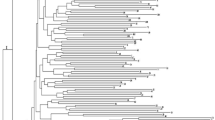Abstract
The genetic variability based on random-amplified polymorphic DNA markers was analysed among 10 cultivated rose varieties and 9 wild species from three different series of the genus Rosa. Using 13 different RAPD primers, 104 polymorphic DNA fragments with a high potential to differentiate rose genotypes could be produced. A dendrogram displaying the relative genetic similarities among the genotypes shows the existence of large genetic diversity among the cultivated roses as compared to the wild species. Furthermore, the main clusters found here are in agreement with known pedigrees and the classical taxonomy. However, the relationships between cultivated roses as inferred by RAPD markers do not correlate with the classical rose classification system. From the present data it is concluded that cultivated roses display a high level of genetic variability despite the fact that single morphological and physiological characters may be less polymorphic within rose groups. This contrasts with the widely accepted opinion of a lack of genetic variability in roses. This is also in accordance with the reported history of rose breeding which makes it highly probable that rose genomes comprise mosaics of different species genomes. As a consequence, it may be possible to utilize the high genetic variability of all genetic traits not under actual selection by breeders for future breeding programmes.
Similar content being viewed by others
References
Cairns Th (ed): Modern Roses 10. American Rose Society, Shreveport (1993).
Kruessmann G.: The Complete Book of Roses. Timber Press, Portland (1981).
Short KC and Roberts AV: Rosa ssp. (Roses): In vitro culture, micropropagation, and the production of secondary products. In: Bajaj YPS (ed) Biotechnology in Agriculture and Forestry, vol. 15, pp. 376–397. Springer-Verlag, Heidelberg (1991).
Rohlf FJ/NTSYS-PC Numerical Taxonomy and multivariate Analysis System. Exeter Publishers, New York (1989).
Mitton JB: Molecular approaches to population biology. Annu Rev Ecol Syst 25: 45–69 (1994).
Gebhardt C, Salamini F: Restriction fragment length polymorphism analysis of plant genomes and its application to plant breeding. Int Rev Cytol 135: 201–237 (1992).
Paterson AH, Tanksley SD, Sorrels ME: DNA markers in plant improvement. Adv Agron 46: 39–90 (1991).
Hubbard M, Kell J, Rajapakse S, Abbott A, Ballard R: Restriction fragment length polymorphism in rose and their use for cultivar identification. HortScience 27: 172–173 (1992).
Rajapakse S, Hubbard M, Kelly JW, Abbott AG, Ballard RE: Identification of rose cultivars by restriction fragment length polymorphism. Scient Hort 52: 237–245 (1992).
Vainstein A, Ben-Meir H, Zucker A: DNA fingerprinting as a reliable tool for the identification and genetic analysis of ornamentals. Proceedings of the XVIIth Eucarpia Symposium ‘Creating Genetic Variation in Ornamentals’, San Remo, pp. 63–68 (1993).
Ben-Meir H and Vainstein A: Assessment of genetic relatedness in roses by DNA fingerprint analysis. Scient Hort 58: 158–164 (1994).
Torres AM, Millian T, Cubero JI: Identifying rose cultivars using random amplified polymorphic DNA markers. HortScience 28: 333–334 (1993).
Williams JGK, Kubelik AR, Livak KJ, Rafalski JA, Tingey SV: DNA polymorphisms amplified by arbitrary primers are useful as genetic markers. Nucl Acids Res 18: 6531–6535 (1990).
Rafalski JA, Tingey SV: Genetic diagnostics in plant breeding: RAPD's microsatellites and machines. Trends Genet 9: 275–280 (1993).
Doyle JJ, Doyle L: Isolation of plant DNA from fresh tissue. Focus 12: 13–15 (1990).
Sambrook J, Fritsch EF, Maniatis T: Molecular Cloning: A Laboratory Manual, 2nd ed. Cold Spring Harbor Laboratory Press, Cold Spring Harbor, NY (1989).
Spethmann W: Neue Methoden der Vermehrung und Zuechtung von Rosen. In: Rosenjahrbuch 1993, pp. 67–82. Verein Deutscher Rosenfreunde (1993).
Skrotch P, Tivang J, Nienhuis J: Analysis of genetic relationships using RAPD marker data. In: Application of RAPD Technology to Plant Breeding, pp. 26–30. Joint Plant Breeding Symposia Series (1992).
Bagheri A, Paull JG, Langridge P, Rathjen AJ: Genetic distance detected with RAPD markers among selected Australian commercial varieties and boron-tolerant exotic germplasm of pea (Pisum sativum L.). Mol Breed 1: 193–197 (1995).
Karihaloo JL, Brauner S, Gottlieb LD: Random amplified polymorphic DNA variation in the eggplant, Solanum melongena L. (Solanaceae). Theor Appl Genet 90: 767–770 (1995).
De Vries DP, Dubois LAM: On the transmission of the yellow flower colour from Rosa foetida to recurrent flowering hybrid tea-roses. Euphytica 27: 205–210 (1978).
De Vries DP, Dubois LAM: Inheritance of the recurrent flowering and moss characters in F1 and F2 hybrid tea x R. centifolia muscosa (Aiton) syringe populations. Proceedings Eucarpia Ornamentals Meeting on Rose Breeding, Ahrensburg.
Semeniuk P: Inheritance of recurrent blooming in R. wichuraiana. J Hered 62: 203–204 (1971).
Svejda F: Inheritance of winterhardiness in roses. Euphytica 28: 309–314 (1979).
Millan T, Osuma F, Cobos S, Torres AM, Cubero JT: Using RAPDs to study phylogenetic relationships in Rosa. Theor Appl Genet 92: 273–277 (1996).
Beales P: Roses, Harvill Publishers, London (1992).
Author information
Authors and Affiliations
Rights and permissions
About this article
Cite this article
Debener, T., Bartels, C. & Mattiesch, L. RAPD analysis of genetic variation between a group of rose cultivars and selected wild rose species. Mol Breeding 2, 321–327 (1996). https://doi.org/10.1007/BF00437910
Received:
Accepted:
Issue Date:
DOI: https://doi.org/10.1007/BF00437910




